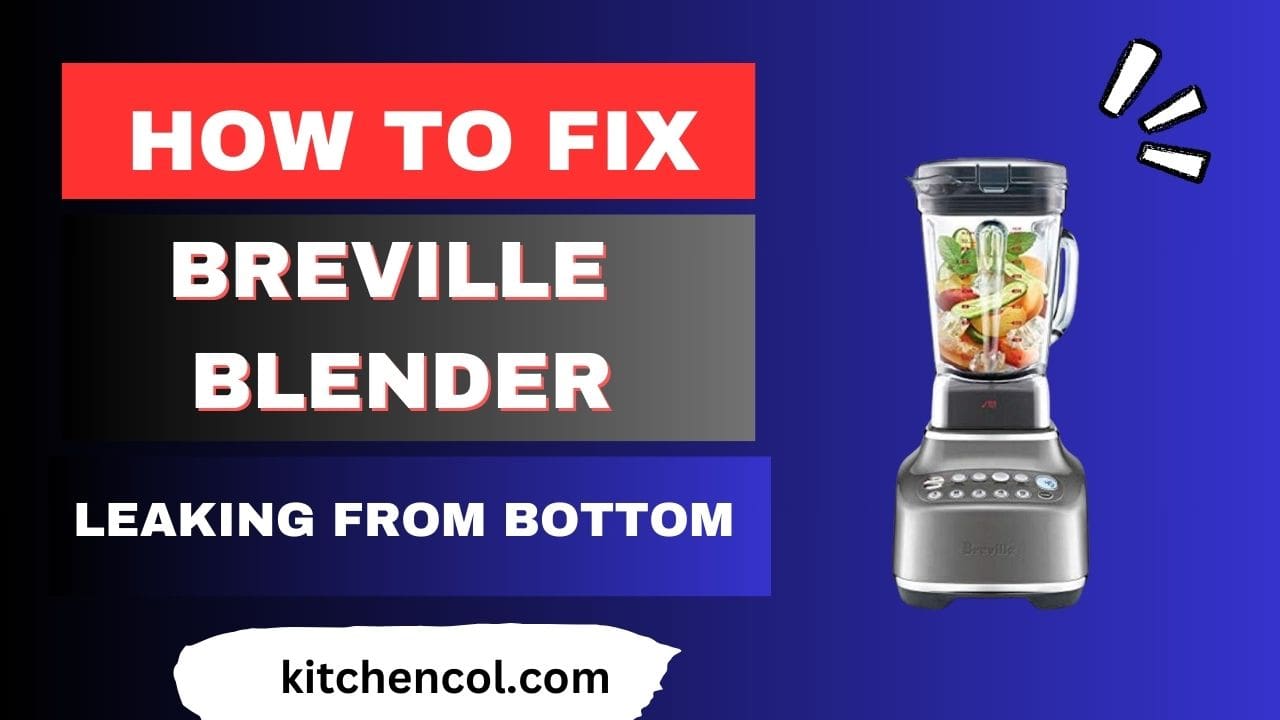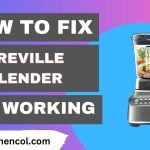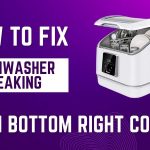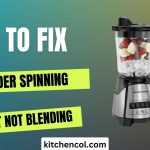Blenders have become indispensable kitchen companions, making our lives easier with every whirl and whir. Breville, a renowned brand in the world of kitchen appliances, has consistently delivered top-notch blenders loved by culinary enthusiasts. However, even the most dependable machines can face hiccups from time to time. One such issue that may leave you puzzled is a Breville blender leaking from the bottom.
Do not worry if you have found yourself in this situation. In this comprehensive guide, we’ll unravel the mystery behind those unsightly leaks, empower you with troubleshooting skills, and offer solutions to ensure your Breville blender remains a leak-free culinary partner. Join us as we dive into the world of blenders, discovering the common culprits behind these leaks and providing practical steps to fix the issue, ensuring your blending adventures continue without a drip.
Understanding the Breville Blender
The Breville blender, a staple in kitchens around the globe, is renowned for its exceptional blending capabilities and user-friendly design. This versatile kitchen appliance is designed to simplify food preparation tasks, from whipping up nutritious smoothies to crafting delectable soups and sauces.
At its core, a Breville blender consists of several key components. The powerful motor is the heart of the machine, providing the necessary force to blend ingredients to perfection. The blending jug, typically made of high-quality materials like BPA-free Tritan plastic or glass, holds the ingredients and ensures they are thoroughly mixed.

One crucial element that often goes unnoticed is the blender’s bottom seal or gasket. This unassuming rubber or silicone ring plays a pivotal role in preventing leaks and ensuring a seamless blending experience. It forms a tight seal between the jug and the base, effectively containing liquids and ingredients during operation.
The Breville blender’s intuitive controls, including variable speed settings and preset programs, make it user-friendly, catering to both novice and experienced cooks. Additionally, many Breville blenders feature innovative technologies such as blade systems designed for precision blending and noise reduction.
In summary, understanding the Breville blender means appreciating its robust construction, blending prowess, and the importance of components like the bottom seal that contribute to its overall performance. Whether you’re a culinary enthusiast or a health-conscious individual, a Breville blender is a valuable addition to your kitchen arsenal, promising a world of culinary possibilities.
Common Reasons for Leaking
A Breville blender leaking from the bottom can be a frustrating experience, but understanding the common reasons behind this issue is the first step to solving it. Let’s explore the most frequent culprits responsible for those unwanted leaks:
Worn or Damaged Gasket or Sealing Ring:
The gasket or sealing ring is a rubber or silicone component located at the base of the blending jug. Over time, it can wear out, become cracked, or lose its elasticity, leading to a compromised seal. When this happens, liquids and ingredients can seep out from the bottom.
Loose or Improperly Assembled Parts:
A loose or incorrectly assembled blender can result in leaks. Make sure all components, including the blade assembly, jug, and base, are securely and correctly attached. If any part is not fitted snugly, it can allow liquid to escape during blending.
Overfilling the Blender:
Overfilling the blending jug is a common mistake that can lead to leaks. When you exceed the maximum capacity recommended by the manufacturer, the blender may struggle to contain the ingredients, causing liquid to escape through the bottom of the lid.
Jug Damage:
Cracks or damage to the blending jug can compromise its ability to hold liquids securely. Check the jug for any visible cracks, chips, or defects, as these can be a source of leaks.
Blade Assembly Issues:
The blade assembly is another critical component. If it’s not correctly aligned or if the gasket within it is damaged, it can allow liquid to escape during blending.
Improper Cleaning or Maintenance:
Neglecting regular cleaning and maintenance can contribute to leaks. Residue buildup, especially around the gasket and blade assembly, can compromise the blender’s seal. Cleaning and inspecting these parts regularly can prevent this issue.
Age and Wear:
Like all appliances, blenders have a finite lifespan. With extensive use over the years, the blender’s components may naturally wear out, increasing the likelihood of leaks. In such cases, it may be necessary to replace specific parts or consider getting a new blender.
Understanding these common reasons for a Breville blender leaking from the bottom is essential for effective troubleshooting. By identifying the specific cause of the leak, you can take the necessary steps to address the issue and ensure your blender continues to serve you well.
Diagnosing the Problem
When your Breville blender is leaking from the bottom, identifying the root cause is crucial for effective troubleshooting. Here’s a step-by-step guide to diagnosing the problem:
- Inspect the Blender’s Exterior: Start by examining the exterior of the blender for any visible signs of leakage. Check if liquid is pooling around the base or dripping from any seams.
- Check the Jug: Carefully remove the blending jug from the base and inspect it for cracks, chips, or damage. Even minor flaws can compromise the seal.
- Examine the Gasket: Inspect the gasket or sealing ring, which is located at the bottom of the jug. Look for wear, tears, or deformation. A damaged gasket is a common cause of leaks.
- Verify Assembly: Ensure that all blender components, including the jug, blade assembly, and base, are correctly assembled and securely attached. Loose parts can lead to leaks.
- Review Filling Level: Consider whether you may have overfilled the blender. If the liquid level exceeds the recommended capacity, it can lead to leaks during blending.
- Test with Water: For a controlled test, fill the jug with water to a level below the maximum capacity, and run the blender. Observe whether water leaks from the bottom during operation.
- Listen for Unusual Noises: Pay attention to any unusual noises, such as grinding or rattling, which may indicate misalignment or damage in the blade assembly.
- Inspect the Base: Check the blender’s base for any signs of damage, such as cracks or leaks originating from within the base.
By methodically diagnosing the problem using these steps, you can pinpoint the issue causing your Breville blender to leak from the bottom. Once identified, you’ll be better equipped to take the appropriate measures to address the problem, whether it’s replacing a worn gasket, tightening loose components, or seeking professional assistance if necessary.
Fixing the Leaks
Now that you’ve diagnosed the issue causing your Breville blender to leak from the bottom, it’s time to take action and resolve the problem. Here are steps to help you fix those bothersome leaks:
- Replace the Gasket: If you found a damaged or worn gasket during your diagnosis, replace it with a new one. Make sure to purchase the appropriate gasket compatible with your Breville blender model. Carefully install the new gasket, ensuring it’s seated correctly.
- Reassemble Properly: Ensure that all blender components are correctly and securely assembled. This includes aligning the jug with the base and the blade assembly, making sure they fit snugly. Double-check that everything is tightened to prevent any loose connections.
- Avoid Overfilling: Be mindful of the maximum fill line indicated on the blending jug. Avoid overfilling, as this can cause leaks. Blend ingredients in batches if necessary to stay within the recommended capacity.
- Inspect for Damage: If you identified damage to the blending jug or other components during diagnosis, consider replacing the damaged part. It’s essential to maintain the integrity of all blender elements for leak-free operation.
- Test the Blender: After making these adjustments or replacements, conduct a test run with water to ensure the leaks have been resolved. Run the blender for a few seconds to check for any signs of leakage from the bottom.
- Regular Maintenance: To prevent future leaks, incorporate regular maintenance into your routine. Clean the blender thoroughly after each use, paying attention to the gasket and blade assembly. Store the blender with care to prevent damage.
By following these steps and addressing the specific issue identified during diagnosis, you can effectively fix the leaks in your Breville blender. With proper maintenance and attention to detail, your blender should return to its leak-free, efficient blending performance.
Maintenance and Care
Ensuring the longevity and leak-free performance of your Breville blender goes beyond just fixing issues when they arise. Regular maintenance and proper care play a vital role in keeping your appliance in top shape. Here’s a guide on how to maintain and care for your Breville blender:
- Cleaning: After each use, disassemble the blender components and clean them thoroughly. Pay special attention to the jug, blade assembly, and gasket. Remove any leftover material with a brush and warm, soapy water. Rinse and allow to air dry.
- Gasket Maintenance: Inspect the gasket periodically for wear or damage. Replace it if needed. Lubricate the gasket occasionally with a food-grade lubricant to maintain its flexibility.
- Storing: Store the blender with care. Keep it away from direct sunlight in a cool, dry location. Store the jug separately to prevent any damage or warping.
- Regular Inspections: Routinely check for any signs of wear or damage in all parts, including the jug, blade assembly, and base. Promptly address any issues you find.
- Usage Guidelines: Follow the manufacturer’s guidelines for blending. Avoid using the blender for tasks beyond its capacity or with excessively hot ingredients.
By incorporating these maintenance and care practices into your routine, you can extend the life of your Breville blender and minimize the likelihood of leaks or other issues. A well-maintained blender ensures consistent performance and delicious results in your culinary adventures.
When to Seek Professional Help
While many issues with a Breville blender can be resolved through DIY solutions, there are instances when it’s best to seek professional assistance:
- Persistent Leaks: If your blender continues to leak despite your efforts to fix it, it may indicate a more complex problem that requires a technician’s expertise.
- Electrical Issues: Any electrical problems, such as malfunctioning motors or switches, should be addressed by a professional to avoid safety hazards.
- Warranty Coverage: If your blender is still under warranty, contact Breville customer support or an authorized service center. Attempting DIY repairs might void the warranty.
- Unusual Noises or Odors: If your blender produces unusual sounds or smells during operation, it’s a sign of internal issues that should be evaluated by a professional technician.
In these situations, it’s wise to prioritize safety and the long-term functionality of your blender by consulting a qualified technician or contacting Breville’s customer support for guidance.
Also Read: How to FIx Breville Blender Flashing Red Light
Conclusion
Fixing a Breville blender leaking from the bottom can be a manageable task with the right knowledge and approach. By diagnosing the problem, replacing damaged parts, and practicing regular maintenance, you can ensure your blender serves you well for years to come.
Remember to follow usage guidelines, avoid overfilling, and maintain proper assembly. However, if issues persist or involve electrical problems, don’t hesitate to seek professional help, especially if your blender is under warranty. With these strategies, you can enjoy a leak-free, reliable Breville blender, empowering you to continue blending your favorite recipes with ease and confidence.

My name is Manan Bukhari and I am an expert in reviewing kitchen products for years. I have a passion for testing multiple gadgets especially related to home & kitchen. I love to spend my free time in resolving issues if I face some in any of my daily use things. I have fixed multiple gadgets of my home on my own without any assistance and that thing gave me confidence to make a blog on troubleshooting of items that are for daily use to assist you folks. Even my wife praises me for having such talent. I always explore new machines on my own because this thing fascinates me.



